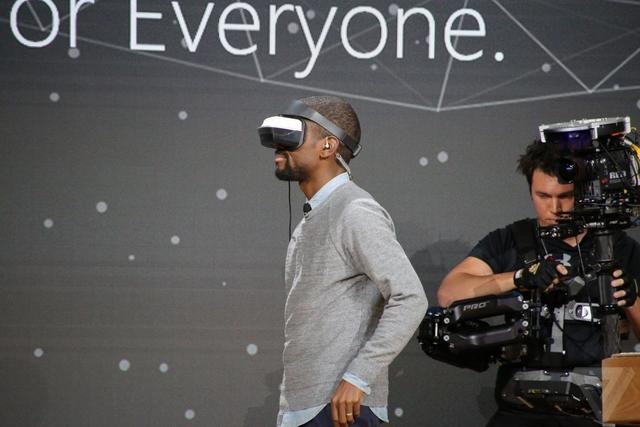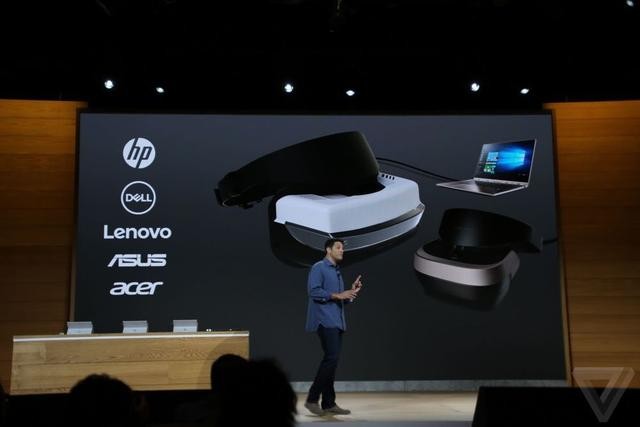Although Microsoft has not revealed more details about its virtual reality system, at least for now, the relatively independent and 6-degree tracking system has made us full of expectations.

At the just-concluded Microsoft conference, the most eye-catching is the new SurfaceStudio all-in-one desktop, but Microsoft also launched a big move in the virtual reality field: that is, a whole new set of built-in independent tracking sensors, the price A virtual reality headset that is less than $299 (about RMB 2027).
Microsoft's partners include ASUS, Acer, Lenovo, Hewlett-Packard, Dell and other major PC manufacturers around the world, and at the press conference Microsoft just showed a little, but did not introduce too much. But when we experience more of what this virtual reality platform can do after the meeting, we also know what this means for Microsoft.
"We have partnered with top PC vendors and hope to ship a range of virtual reality headsets for less than $299 and be able to meet users in 2017," Microsoft said on its official Twitter.
So for Microsoft's virtual reality platform, we have to have a look at seven points.
6-degree independent tracking from inside to outside is significant
One of the big selling points of Microsoft's virtual reality platform is the use of 6-degree tracking technology from the inside out. If Microsoft succeeds, it means a major breakthrough in the field of virtual reality. 6-degree free tracking means tracking the user's position in space, not just tracking the user's head position. This feature is also an important distinction between high-end virtual reality devices and inexpensive devices, such as OculusRift, GearVR or Google Cardboard.
Many virtual reality systems currently support 6-degree free tracking, but most require external trackers, such as HTCVive and OculusRift, and require more complex settings, which are more restrictive in terms of mobility. Microsoft's virtual reality platform does not rely on external cameras or locators to track user position changes, but directly through the built-in sensors to detect the wearer's uniqueness in space and data matching. According to Microsoft CEO Terry Myerson, this means that users do not need to provide a dedicated mobile space for the virtual reality system, and they can move freely with the headset.
What is the difference with HoloLens?
Obviously, Microsoft's HoloLens is an augmented reality device (Microsoft prefers to call it a mixed reality) that blends virtual holographic projection into the surrounding real world. The virtual reality device completely separates us from the surrounding environment and covers the entire virtual element in the field of view. Although both can load the same 3D object, the virtual reality device will be a completely virtual environment, and HoloLens will add virtual objects in the environment we can see.
In fact, there are some similarities between the two, such as HoloLens also uses a tracking method from the inside out.
How much can you move?
This is actually a problem worthy of attention. Because of the tracking method from the inside out, this independent headset can theoretically follow the user's movement completely. As long as there is physical space, the headset can tell. Where are you going? However, in reality, this requires hardware and software to accurately track long-distance locations. HoloLens allows us to move around the room, but the world looks at the actual experience, if you move on the edge, the effect will be somewhat affected.
In the presentation of the conference, the moving distance is not too big, just moving from one segment to another, but this is a huge improvement compared to devices like GearVR. After all, we will not feel sick during the move. And dizziness. And this has a similar experience to headsets like HTCVive and OculusRift.
Computer configuration requirements
From the current point of view, Microsoft's new virtual reality platform is not completely independent of use like HoloLens, and it also needs to rely on Windows 10 system computer equipment. However, unlike OculusRift and HTCVive, which have quite high requirements for PC configuration, the computer that drives Microsoft's virtual reality device at the conference should be just a normal Lenovo Yoga notebook, not a professional game PC. This means that Microsoft's virtual reality platform is not too high for PC configuration requirements, but this means that the ability to parse graphics is more general.
On the other hand, it is worth noting that both HP and Dell offer their own virtual reality backpack products, each using their own Omen and Alienware brands. Currently, only HTCVive is supported, but I believe that it will be perfectly adapted to Microsoft's virtual reality system headsets in the future.

How to control
Controllers are already a very important aspect for virtual reality devices, including HTC and Sony PlayStationVR, which have already released their own controllers, and the Oculus Touch will be available soon in December. Even Google's DaydreamVR platform provides a simple controller for operation.
At the press conference, Microsoft did not show us a dedicated controller. On the stage, just like HoloLens, it interacted with the headset through voice. If Microsoft uses HoloLens' camera technology in a virtual reality system, it can even recognize the user's facial movements. Although this is not the most effective way to control, it at least cleverly solves the basic interaction problem without using any new hardware. For more complicated operations, users can continue to use the keyboard, mouse and gamepad.
Relationship with Oculus
A year ago, Microsoft and Oculus seemed to have a very pleasant relationship, the OculusRift would be compatible with the XboxOne's handles, and the OculusRift could run some of the XboxOne games. However, there has been no follow-up news for this cooperation, and Oculus has not been seen at this conference. However, if you understand the previous Oculus conference, you can guess that the relationship between the two should have been terminated.
You can say that Microsoft's virtual virtual reality system is completely different from HTCVive or OculusRift in terms of internal and external tracking, and can be used independently, but just a few weeks ago at the Oculus conference, the latter also announced a development code for SantaCruz's standalone virtual reality headset prototype. Although the virtual reality device from Microsoft's demo is not independent, it still needs to be connected to a PC, but if the two companies really continue to cooperate, this line should disappear.
When is it officially released, how is the price?
At the moment we don't know the exact name of the Microsoft Virtual Reality System device, nor do we know what it will be. Microsoft said its virtual reality headset will be officially released in 2017, and is currently only described as part of the Windows 10CreatorsUpdate 3D upgrade program. If you want to know all the information, at least until next spring. We should see more news on WinHec in Shenzhen, China next year.
As for the price, Microsoft has already stated that it will sell for $299 (about RMB 2030), for PlayStationVR of US$399 (about RMB 2,700), OculusRift for US$599 (about RMB 4,060), and US$799 (about HTCVive with RMB 5,417 yuan) is cheap. However, the specific price should be different for different manufacturers. At the same time, Myerson said that because the effect is amazing, Microsoft's virtual reality device price will not be too low, of course, does not rule out occasional special models.
At present, Microsoft's commitments still have some elements that are not fully realized in the current mainstream virtual reality technology, and it looks very different. So far, all the virtual reality headsets on the market have almost appeared, and the price is often higher than we expected. And before Microsoft fully announces more details about its virtual reality system, we should consider who will become its competitor, at least OculusRift and HTCVive are not strictly speaking. Of course, if Microsoft can recruit more partners, then this is also a very exciting product.
Bowl chopper and vacuum mixer are widely used in sausage production line,including bowl cutter,bowl chopper,meat mixer,vacuum bowl cutter,vacuum cutter,vacuum mixer. Only the excellent performance machines can guarantee the high quality of products. 30 years of experience allows us to design the most advanced chopping and mixing machines. Vacuum sealing technology is applied in these machines preventing protein and fat being oxygenized and damaged, keeping freshness, original color and taste, reducing air bubbles and enhancing flexibility.
The vacuum mixer adopts double shaft and helix paddle structure, which will mix raw material in circle movement, to reach the perfect mixing effect.
Bowl cutter can cut meat into emulsified paste by high speed chopping knives and mix up other additives into meat sufficiently.
Bowl cutter series:
High speed bowl cutter 80L
High speed bowl cutter 125L
High speed bowl cutter 200L
High speed bowl cutter 330L
Vacuum bowl cutter 125L
Vacuum bowl cutter 200L
Mixer series
Common meat horizontal mixer 60L, 150L, 400L, 650L, 800L, 1200L
Vacuum meat horizontal mixer 60L, 150L, 300L, 650L, 800L, 1200L
The application of Chopper And Mixer Series
Raw sausage
Cooked sausage
Smoked sausage
Scalded sausage
Canned meat
Pies
Soups and sauces
And much more ...
Industrial Meat Mixer,Vacuum Meat Mixer,Chopper And Mixer Series,Bowl Cutter,Bowl Chopper,Meat Mixer,Vacuum Bowl Cutter,Vacuum Cutter,Vacuum Mixer
Helper Machinery Group Co., Ltd. , https://www.helperfoodtek.com